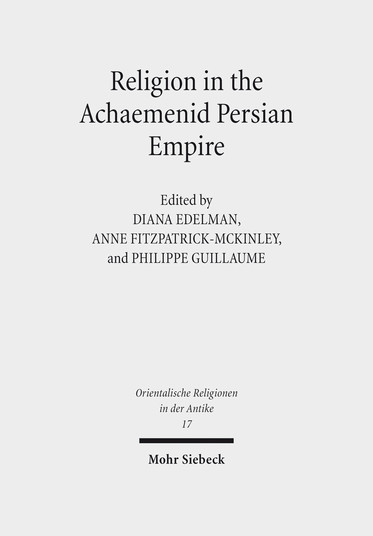Jewish Studies
Religion in the Achaemenid Persian Empire
Emerging Judaisms and Trends
Ed. by Diana Edelman, Anne Fitzpatrick-McKinley, and Philippe Guillaume
[Religion im Achämenidenreich. Entwicklungen des Judentums und anderer Religionen.]
144,00 €
including VAT
including VAT
cloth
ISBN 978-3-16-153960-2
available
Also Available As:
Published in English.
The Achaemenid Persian imperial rulers have long been held to have exercised a policy of religious tolerance within their widespread provinces and among their dependencies. The fourteen articles in this volume explore aspects of the dynamic interaction between the imperial and the local levels that impacted primarily on local religious practices. Some of the articles deal with emerging forms of Judaism under Achaemenid hegemony, others with Achaemenid religion, royal ideology, and political policy toward religion. Others discuss aspects of Phoenician religion and changes to Egyptian religious practice while another addresses the presence of mixed religious practices in Phrygia, as indicated by seal imagery. Together, they indicate that tolerance was part of political expediency rather than a universal policy derived from religious conviction.Survey of contents
Part I: Trends in Emerging Judaisms
James Anderson: Creating Dialectical Tensions: Religious Developments in Persian-Period Yehud Reflected in Biblical Texts – Philip R. Davies: Monotheism, Empire, and the Cult(s) of Yehud in the Persian Period – Russell Hobson, Were Persian Period 'Israelites' Bound by Ethnicity or Religious Affiliation? The Case of the Southern Transjordan – Philippe Guillaume: Non-violent Re-readings of Israel's Foundational Traditions in the Persian Period (the Calendar System in P) – Lowell Handy: Josiah as Religious Peg for Persian Period Jews and Judaism – Christian Frevel / Katharina Pyschny: A Religious Revolution Devoursits Children. The Iconography of the Persian Period Cuboid Incense Burners
Part II: Other Religious Trends in the Persian
Anne Fitzpatrick-McKinley: Continuity between Assyrian and Persian Policies Toward the Cults of their Subjects – Jason M. Silverman: Was There an Achaemenid 'Theology' of Kingship? The Intersections of Mythology, Religion, and Imperial Religious Policy – Yannick Muller: Religion, Empire and Mutilation: A Cross-Religious Perspective on Achaemenid Mutilation Practices – Diana Edelman: Iconography on Double-Shekel Sidonian Coinage in the Persian Period: Is It a God or a King in the Chariot? – Mark Christian: Whose Rites and Whose Wrongs? Religious Contributions of Contingents within the Persian Navy – Damien Agut-Labordère: Political Piety-for-Predation Policy: Persian and Egyptian Gods during the Achaemenid Period – Jared Krebsbach: Achaemenid Persian Patronage of Egyptian Cults and Religious Institutions in the Twenty-seventh Dynasty: A Study of Political Acumen in the Ancient World – Deniz Kaptan: Religious Practices and Seal Imagery in Achaemenid Hellespontine Phryia
